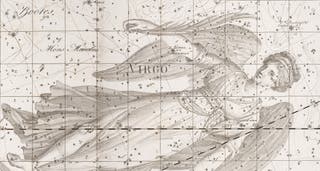Aratus Solensis. Hug. Grotii Syntagma Arataeorum. Leiden, 1600.
After the initial edition of 1499, the Phaenomena of Aratus, along with its three classical commentaries, was regularly reprinted, but usually as part of a package that included Hyginus's Poeticon, the Sphere� of Proclus, and other ancient astronomical writings. But in 1600 Hugo Grotius published a beautiful edition of the Aratea alone. His book was the direct result of his acquisition of an exquisitely illuminated ninth-century manuscript of Aratus, in the Germanicus Caesar version. Grotius called on the notable engraver Jacobus De Gheyn to convert the manuscript paintings into engravings, and these were incorporated into the printed book.
We reproduce Aquarius above, and images of Andromeda and Cassiopeia are below. Not only are these the finest constellation figures printed to date, but they would have a long-lasting influence on celestial iconography, since De Gheyn's engravings served as inspiration, and occasionally as explicit models, for many of the constellation figures in Bayer's Uranometria.
Many modern commentators seem unaware of the role played by the ninth-century manuscript, for it is often said that the De Gheyn illustrations were based on the woodcuts in the 1482 edition of Hyginus, and this is simply not true. The Aratus manuscript owned by Grotius survives to this day; it is one of the treasures of the Reijksuniversitet in Leiden, and it is known to scholars as MS Voss. lat. Q79.

